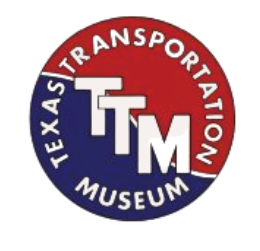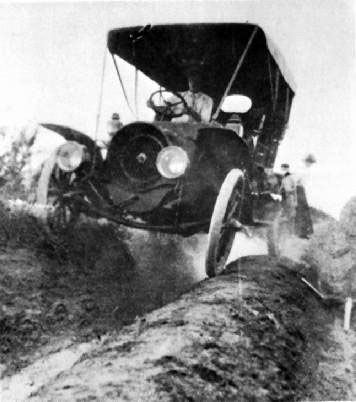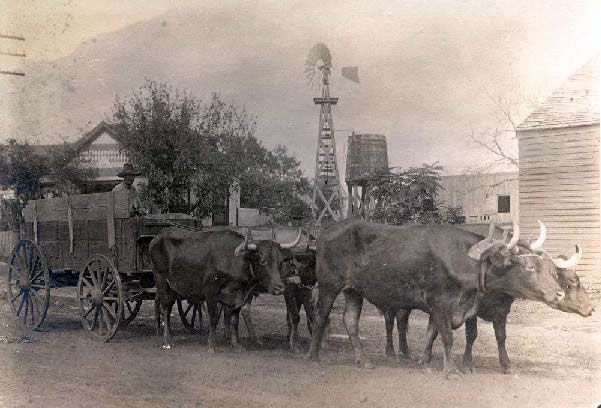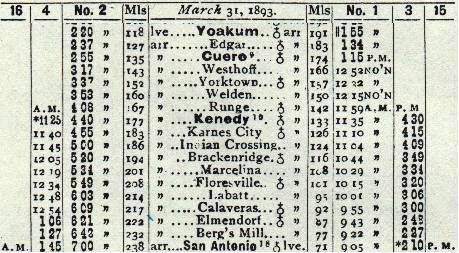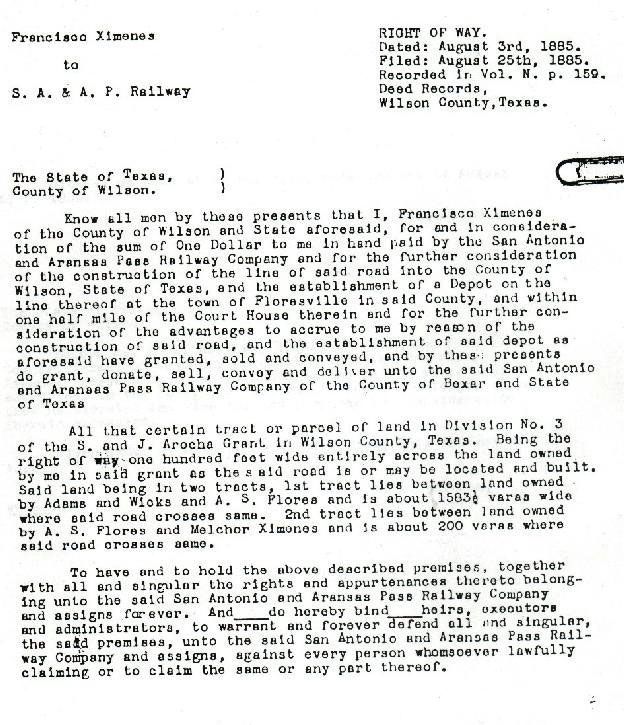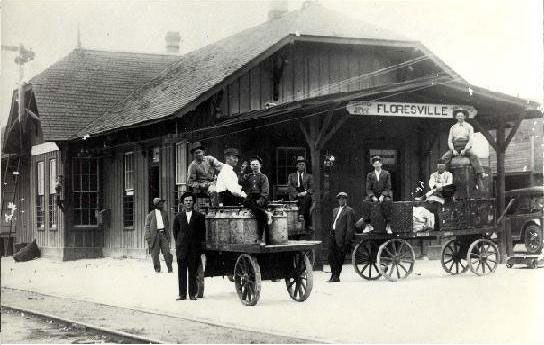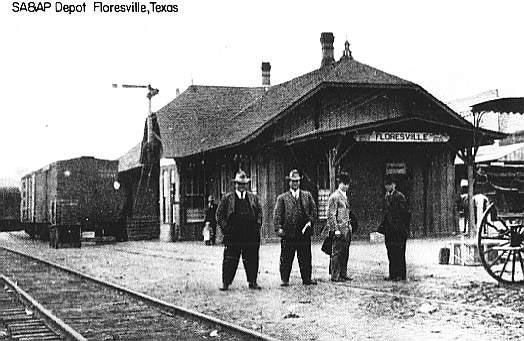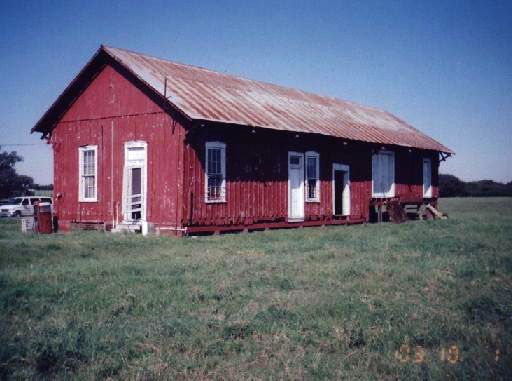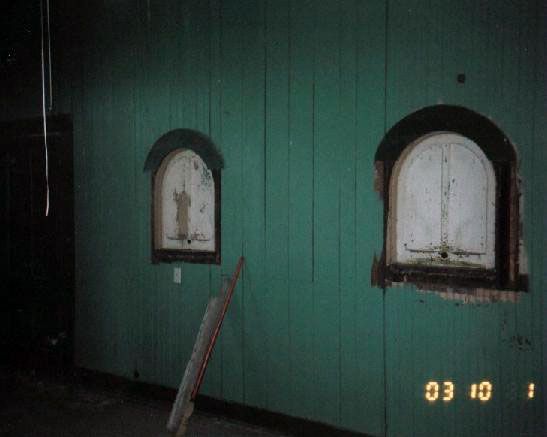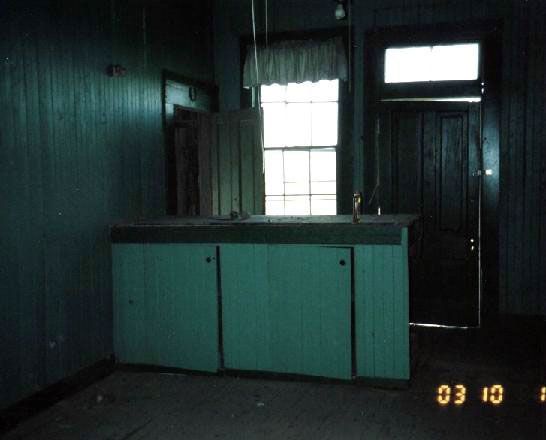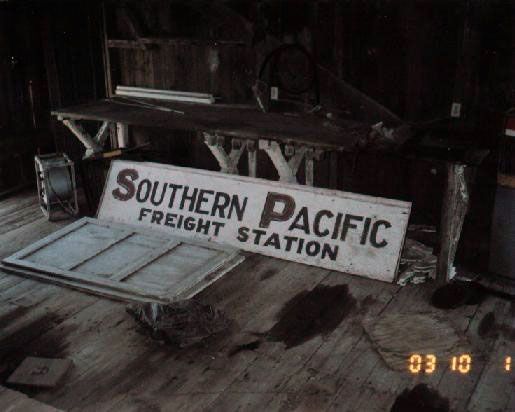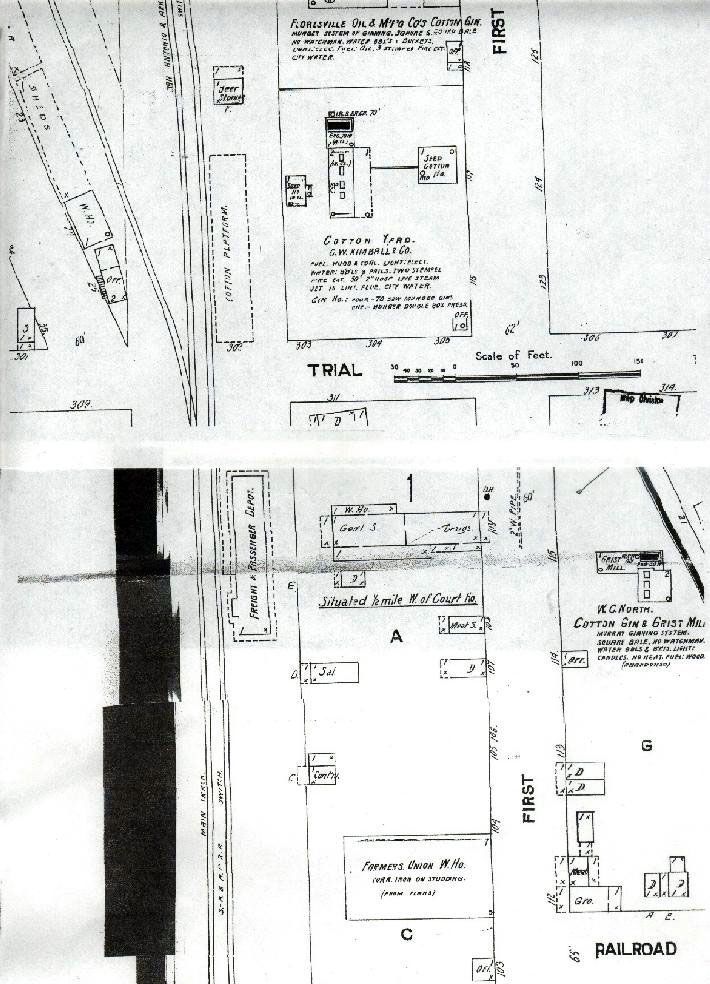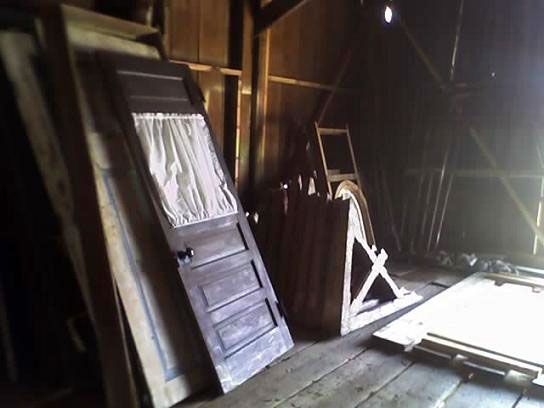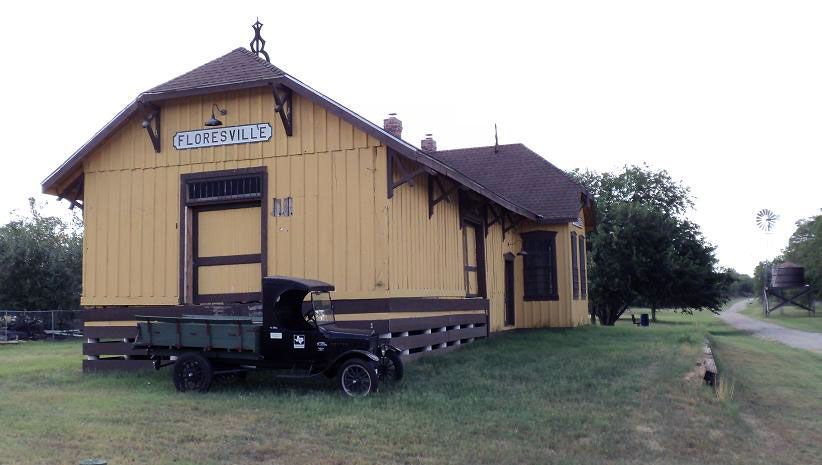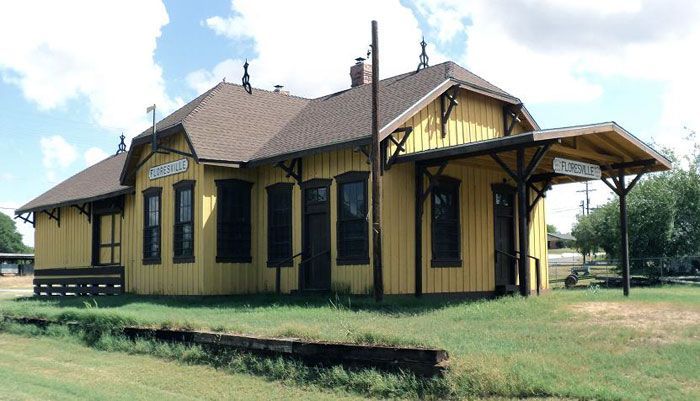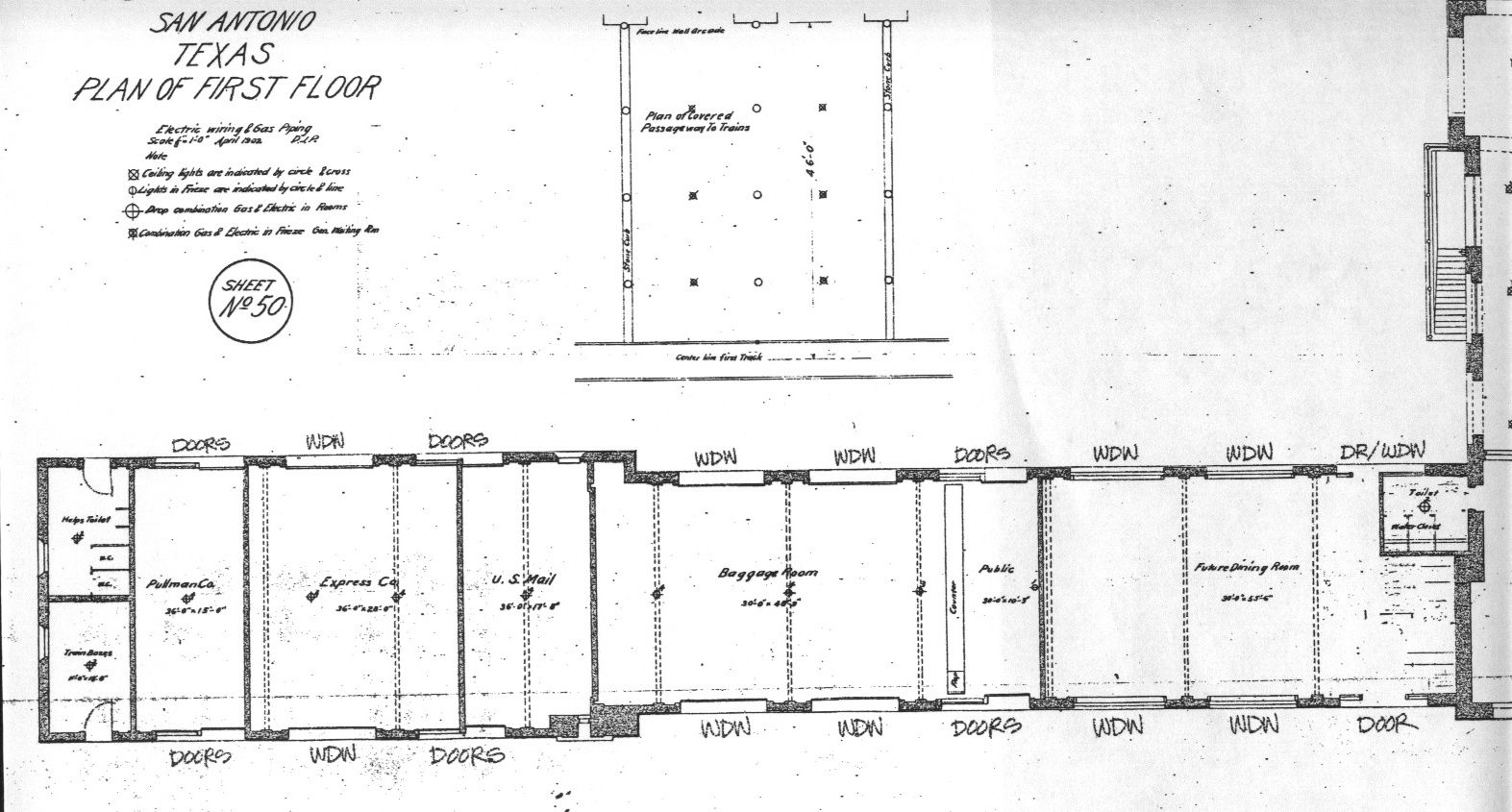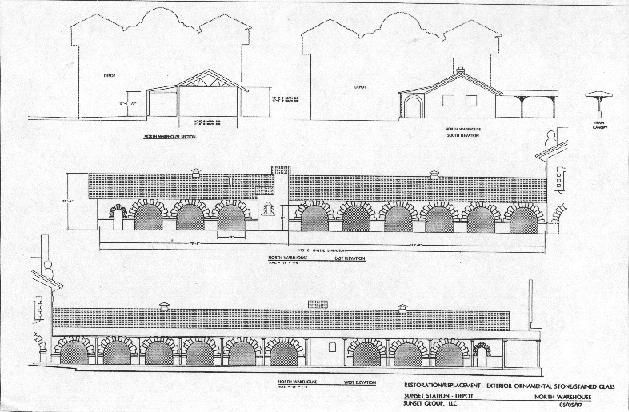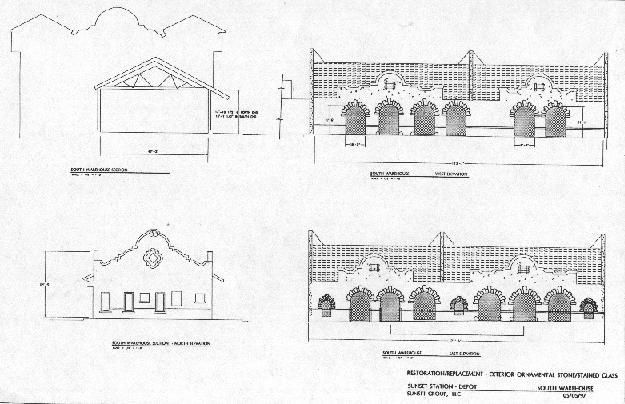Floresville and the Railroad
The museum is indebted to several organizations and people in Floresville for their generous assistance with this project. The local library, the court house archives and the local newspaper, the Floresville Chronicle-Journal all provided generous guidance. LaJuana Newnam of the Wilson County Abstract Company and also of the Floresville Historical Society went out of her way to make sure this project got off to a good start. It would be difficult to underestimate the contribution of Colonel Jesse Perez, retired United States Army, who is the Executive Director of the Floresville Economic Development Corporation. It is thanks to his diligence in compiling an impressive dossier on the history of the railroad in Floresville that much of this information is available. Mr. Perez is also the driving force behind the city's re-acquisition of its old depot and the drive to re-locate it at its original site, not to mention the planned hike and bike trail along the old railroad right of way across the town.
Floresville's claim to rail fame is that it was the first town to be reached by the San Antonio & Aransas Pass Railroad, in 1886. These first 30 miles were a miracle of optimism, as the S.A. & A.P. began as it ended, dramatically underfunded. While reaching Floresville is significant in the history of the fondly remembered railroad, what is always omitted is the impact the railroad had on the town and it's development. This page serves to provide more insight into the events that led up to and from the railroad's arrival and tenure.
The first train arrived in Floresville on 1/7/1886. To mark the occasion there was much speechifying and celebration both in San Antonio and Floresville. The train included five passenger cars and carried over nine hundred people, including a four year old child, C.A. Staudt. Mr. Staudt, after 44 years of service on this very line, had already retired but lived to see the end of passenger service to Floresville on 9/24/1950. (Freight service would continue for another 48 years.) He and his mother rode into San Antonio by stage coach to be able to ride the first train. It is not recorded how he returned home after the last one. The new service was a matter of great import to both towns and, indeed, the new railroad. There was a feast that catered to over 2,000 people for the arrival of the first train. In attendance was, of course, Uriah Lott and the entire board of the railroad. Also in attendance was John Ireland, the then Governor of Texas who had earned for himself the soubriquet, the "Sage of Seguin."
The first railroad to be created in San Antonio was off to a good start. They intended to end the city's reliance on the Galveston, Harrisburg & San Antonio Railroad which, as only a small part of the Southern Pacific's trans continental empire, was not thought to be doing enough to help the city grow. And Floresville and the surrounding area farms would be in a much better position to sell their produce. The new railroad itself would use this initial success as a springboard towards its goal of reaching a deep water port nearer to San Antonio than Galveston.
Floresville, some thirty miles to the south east of San Antonio, came into existence because it would be on a projected rail route. While others were created once the railroad had already been built, Floresville began to grow in anticipation of its arrival. Texas was very much still frontier territory in the 1880's. The promise of railroad service galvanized interest into what was then only a tiny hamlet called Lodi. The Flores family owned a large ranch some six miles away. Wilson County was established in 1867. Peanut cultivation began in the area in the early 1870s and a post office was opened around the same time. The town site was mapped out and was named for the Flores family who had a house built there, for proximity to the school and other amenities. A town house for ranch owners was fairly common at this time.
The pace of development picked up in 1883 when it was announced by the newly formed San Antonio & Aransas Pass Railroad that it would be building through Floresville. The town was not asked to pay a bonus, a practice that would soon become commonplace. Trains needed to stop frequently in those early days, every seven miles or so, as their steam engines were voraciously thirsty. Many a town, such as Poth in neighboring Karnes County, would grow around railroad water stops. In the case of Poth the first thing to follow the railroad were cattle pens, since the animals needed water as well and the beast's owners wanted to get them on the trains and to a better selling price. A post office so ranchers could get their mail would follow, then a feed store and a general store, then a saloon, possibly a hotel. When the first church was built, you had a township that meant business.
By 1885, Floresville had a population of 400. It had grown to 1,500 by 1890. It would soon become the seat of Wilson County and be graced with a grand court house commensurate with this status. A railroad in your town was a real blessing in those days. In 1909, the local paper, the Floresville Chronicle-Journal printed a special edition that provides an entertaining insight into what was making the town, and Wilson County, tick at the turn of the last century. It was, in a word, agriculture. Peanuts had emerged as the crop of choice. Floresville is styled as the peanut capital of the world, due to the suitability of the soil and the climate. Most years will yield two crops. The "Special Edition" advises a complimentary herd of hogs as these beasts would clear the harvested fields with alacrity while simultaneously adding nutritious manure. YUM ! In addition watermelons, grapes, cotton, onions, potatoes, tomatoes, corn, cabbage, beets and turnips also do well in the area, along with dairy and cattle.
The depot that was built in Floresville set the style for many a subsequent San Antonio and Aransas Pass depot. he identity of the designer is lost to time. Each railroad tends to have its own building style, and the S.A. & A.P. was no different. The building was, indeed, still is, of generous proportions and stoutly constructed. It has a wooden frame and had a bay style projection on the track side that served both as a ticket window and a way for employees to be able to see up and down the line effectively. Because of the types and volume of goods it was handling, the depot had no less than three loading platforms. The smallest of the three was for baggage and other personal items. In the early days of the railroad, many people did their shopping from a Sears & Roebuck catalog and purchased goods would be delivered to your nearest depot. Many an item, from treadle operated sewing machines to entire houses were delivered all over the country this way. Major items, like kit form houses, agricultural equipment and other heavy bulk goods would be delivered to the hard freight loading dock. Equipment for handling such heavy freight was rudimentary in the early days so it may be assumed a fair amount was done with blocks and tackle and the sweat of strong muscles. The third loading dock was for soft freight, which is to say agricultural produce. All around the depot were businesses dedicated to the swift processing and packaging of fruit and vegetables, which would be delivered to the train by ox drawn carts directly from the farm. Such perishable items needed to be moved quickly if they were not to spoil under the Texas sun and many, many people were employed to keep everything moving.
Racial segregation was a part of life in Floresville, just as it was all over America. The railroad lines ran adjacent to what became First Street, several streets to the east of the court house square and the town's Anglo community. The city is still oriented to the now gone rail line. On the "other side of the tracks was South Second Street, then South Third and South Fourth. This area near the station was known by the Hispanic community as 'El barrio del depot.' These streets, like the wealthier areas on the court house side ran parallel to the tracks; they simply counted in the other direction. With the passing of the depot and the produce processing operations that made the system work, and evolving racial integration, the stores that served the predominantly Hispanic residents and the bars they would frequent in the evening are gone, too. Gone is the music and the lively community. And, just as the trains and tracks have vanished into memory, so too have the neighborhood children, who would play around the tracks, laying nails and pennies on the them to be flattened by the passing trains.
In 1925 the Southern Pacific was finally allowed to legally assume full control of the San Antonio and Aransas Pass by the Interstate Commerce Commission, although the "SA & AP" had been essentially under S.P. control for years. The S.A & A.P. line was immediately down graded to secondary status. The main line to Corpus Christi was to be the Missouri Pacific line that runs through Pleasanton some thirty miles to the west. That line was built by another small local company, the San Antonio Uvalde & Gulf. This line was now part of the M.P.'s "Gulf Coast Lines" network. However, service would continue on the S.A. & A.P. for many years.
Floresville business peaked in the 1950's, even as the era of trains was winding down. The town had around 112 businesses, compared to less than 80 today. And while the population has continued to grow - it is now around 6,000 - many people are using the improved roads to commute to work in San Antonio. Passenger service ended on 9/24/1950. Train #313 left at 5:05 AM. Train #314 left at 11:12 PM. Daytime service had ended even earlier. As well as C.A. Staudt there was another veteran railroad employee riding the last passenger train, Mr. H.T. Graham. He had served 49 years on the line, 39 as Floresville agent. Many locals and rail fans were able to take this one last ride.
Smaller businesses were choosing to use the bigger trucks that were becoming available and railroads were obliged to concentrate their operations on industries that need to move vast amounts of tonnage at one time. Fresh agricultural produce began to be almost exclusively moved by refrigerated trucks, rendering the old S.A. & A.P. line redundant, as there is little in the way of heavy industry in this fertile, farming part of Texas. In 1987, "through" freight service from Corpus Christi came to an unplanned end when a bridge further down the line was destroyed in a derailment and it was decided that the cost of rebuilding it could not be justified. Local freight service to Kenedy continued until November of 1993, when the Southern Pacific finally decided that there was no hope of creating sufficient revenue to keep the line viable and all service came to an end. Despite attempts to create tourist service all the line, the final nail in the coffin came in 1998. The tracks were removed in January of 1998, 112 years after it was originally laid. This time there was no ceremony or speeches, just the workaday activities of hard hatted workers and heavy duty track moving equipment. There no longer remains any rail line within Wilson County.
The San Antonio & Aransas Pass Railroad, affectionately remembered as the "SAP", never fared as well as the first town it helped to create. In fact, once Floresville had been reached, its funds were totally depleted. The company was begun without much money to begin with. Some of the original trackage laid was already second hand. Some was former streetcar rail. And their first locomotive had already been consigned to the scrap heap by its original owner when the SA & AP rustled up enough money to acquire it. While managing to reach Floresville remains a phenomenal achievement under such impecunious circumstances, the thirty mile route could never be profitable in and of itself. Fortunately, the general manger of the railroad, Uriah Lott, found a wealthy backer in Mifflin Kenedy, of Corpus Christi, and was able, as result, to continue the line onto towards the gulf.
Another fascinating fact distinguishes Floresville from other towns and settlements along the "SAP" route. According to the legal document granting the railroad land and right of way through the area, the town was actually paid by the railroad and not the other way around. On 8/3/1885, Francisco Ximenes, a local land owner received $1, one whole dollar, for a strip of and one hundred feet wide. The land sale also obligated the construction of a depot which would have to be within half a mile of the planned courthouse.
All subsequent towns along the S.A. & A.P.'s route would be obliged to pay handsomely for such a privilege. When Helena, the county seat of neighboring Karnes county counter offered only half of the requested $60,000.00 subscription, the railroad simply did not go there, even though it was the biggest town between San Antonio and the Gulf of Mexico at the time. A landowner to the west of Helena provided land and funds and new towns emerged along the line, such as Poth and Karnes City. While it has been said that no town was ever hurt by the arrival of the railroad, a decision to avoid one had, in this case, disastrous consequences. Within less than five years, Helena lost its status as county seat along with just about all of its businesses and population. Today it is a ghost town.
There is a very pleasant ending to the story of the railroad and Floresville. (Unusual, too. No other community has done anything like it.) The original depot was purchased by the city via the Floresville Economic Development Council and brought back to its originally site in 2004. While it had undergone some changes since it was removed to a nearby ranch and used as a barn, it has been restored to its former appearance. It was structurally sound and many of its original detailed pieces were carefully removed and stored inside. Most notably it had a different roof and the ticket bay window is gone. Accurate copies of these original features have been be made. There were several similar S.A. & A.P. depots that the builders used as a guide. The old right of way has been turned into a "Hike & Bike" trail, with the depot serving as both a center piece and a museum. Floresville has much to be proud of. The depot is ringing once again with the happy sounds of children and families. Floresville is remaining true to its roots, celebrating its history and progressing into the future with much promise.
The folks at the Floresville Economic Development Council have made great progress with the restoration of the depot and the hike and bike trail as well. Work to recreate the roof and bay window has been done using as much original material as possible. Some of the "missing" elements were actually being stored within the structure itself. Other parts came from some old railroad related warehouses still standing, kinda sorta, in town. Meanwhile the old right of way has never looked so good! Several sections on the south end are all but complete. The FEDC is going to be reinstalling several bridges at the northern end, just as it was when the tracks ran through town.
Transportation Museum
CONTACT US TODAY
Phone:
210-490-3554 (Only on Weekends)
Email:
info@txtm.org
Physical Address
11731 Wetmore Rd.
San Antonio TX 78247
Please Contact Us for Our Mailing Address
All Rights Reserved | Texas Transportation Museum
